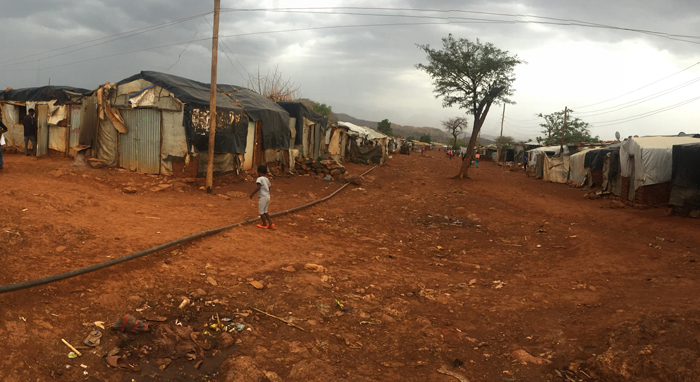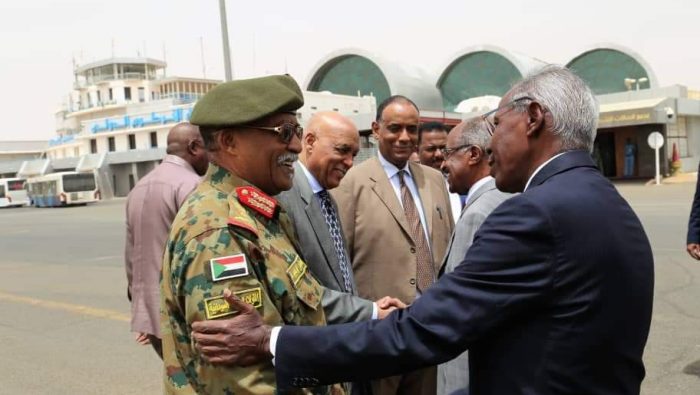Eritreans, in Ethiopia the law for refugee camps changes

Eritreans, in Ethiopia the law for refugee camps changes
From now on, Eritreans in Ethiopian refugee camps will be able to move and work. A good reason not to continue their trip toward the West.
At the beginning of this year Ethiopia approved a new law to allow the million refugees of various nationalities, who live in the 20 refugee camps on Ethiopian territory to work outside the camps.
A noteworthy difference, if we recall that Ethiopia receives the largest number of refugees after Uganda in its camps. People who have so far been invisible, without rights or freedom.
“We are pleased to inform you that the new law on refugees was approved by the Chamber”, said the spokesperson of ARRA, Administration of Refugee and Return Affairs.
“The adoption of this law represents a milestone in the long history of refugee reception by Ethiopia, who have been coming from all the region”, said Filippo Grandi, United Nations High Commissioner for Refugees.
At the root of this change is the adoption of the Global Compact on Refugees In December 2018, during the General Assembly of the United Nations. An agreement for the inclusion of refugees in the national service of the country which hosts them, both from a health point of view and on the education front.
Guaranteeing them freedom of movement and the right to exist legally, which means being able to register births, deaths, marriages.
In Ethiopia the UNHCR participated with ARRA to the drafting of this new law, which replaces the older one of 2004 (Refugee Proclamation) based on the Convention for Refugees of 1951 and on the African Union Convention of 1969. The old law limited some rights, such as freedom of movement and access to education. Also, it did not contemplate integration in the society where the refugee camps are located.
Refugees will now be able to exit the camps, attend schools regularly, work, open bank accounts, get a driving license.
The head of the Commission for Ethiopian investments, Fitsum Arega, said that the new legislation is part of the Job Compact, a 500 million dollar programme aiming to create 100 thousand new jobs, 30 percent of which destined to refugees.
In this way also “refugees will support the development of Ethiopia” twitted Fitsum Arega.
The law will “help refugees feel as included in society” said Dana Hughes, spokesperson of the UN Agency for Refugees for Eastern Africa.
“Furthermore” she added, “it does not only advantage refugees, but also contributes to the country’s economy. Hence this legislation was not only the right thing to do, but also the most intelligent thing.”
In the past the push factor for Eritreans to leave their own country – reaching refugee camps first, and then fleeing abroad – came from the West. Also from the Obama administration.
Once they arrive in Ethiopia Eritreans are sent to the four refugee camps located in the Tigray region, the Ethiopian highland at the border with Eritrea.
These are the camps of Shimbela, Mai-Aini, Adi Harush and Hitsats.
Shimbela is the oldest, created in 2004. Then in 2008 the Mai-Aini camp was opened, which hosts about 18 thousand refugees. Then in 2010 the Adi Harus camp was opened where 29 thousand people are registered. Here, until 2012, people lived in tents, now replaced by houses made of mud and earth.
Before the new law you could leave the refugee camps legally only for very serious health reasons or for university studies. In both of these cases, a government pass was necessary.
The OCP, Out of Camp Policy, regulation established, for instance that in the case of Eritreans, such exits were authorized only for those who had been in the camp for at least six months, with a clean police record and a reference sponsor in the case of those asking to study outside.
In past years these permissions were granted to 2.800 Eritreans.
Mr. Giancarlo Penza, of the Comunità Sant’Egidio tells us about the situation of Eritreans in the refugee camps.
The Comunità Sant’Egidio, like many other lay and religious institutions, activated the first humanitarian corridors from Ethiopia towards Italy.
The corridors are a channel provided by Italian law for the re-integration of refugees. The bodies which activate them must guarantee to the State that they provide refugees with food and accommodation as well as help for their integration.
However, the numbers of those who arrive with humanitarian corridors, compared to the flux by sea, (141 thousand people in 2018) are very small. The organizations who participate in this project may receive, by law, a maximum of 1.000 refugees in two years.
With regards to Eritreans, however, after the peace with Ethiopia, the arrivals in Italy have plunged. They are no longer in the first ten nationalities UNHCR.
“The peace between Eritrea and Ethiopia”, said Mr. Penza “ had a very favourable impact on Ethiopian public opinion. All were happy, but for the time being the flux of Eritreans towards Ethiopia has not decreased.”

Humanitarian corridors, arrival in Italy. Giancarlo Penza, Sant’Egidio, with vice foreign mininster Emanuela Del Re
The IOM (International Organization of Migration) and NRC, Norwegian Refugee Council declare, with regards to the arrivals, that the majority of young Eritreans, who are in refugee camps do not want to stay there. Ethiopia is just a stop over before they reach other destinations: Europe, America, Canada.
“There was a change after peace, though” continued Penza “because now that the frontiers on the highland are open and no longer militarized, people can enter Ethiopia freely. The flux of migrants, thus, has not stopped, yet. To-date about 200 Eritreans on average per day allegedly enter and ask at the border to be received as refugees” explained Mr. Penza.
“It appears” he continued “that for the time being Eritrea and Ethiopia have not taken an official stance on these arrivals. Immediately after peace there was uncertainty. Many refugees told us that they could no longer register, just because there was free access. For now, though, there have been no changes.”
So what happens when Eritreans cross the border and arrive in Ethiopia?
“The system of refugee camps is still the same. Eritreans arrive in the North of the country, in the Tigray region. As soon as they cross the border, they go to a camp at about 50 km distance, Endabaguna. Here they are registered. They are asked about their identity and where they come from. Then they are questioned by an ARRA officer. Then they are sent to one of the four camps for Eritreans, which are all fairly close together.
Between ARRA and the UNHCR there is close co-operation.
So far, though, refugees have lived in closed camps…
“The camps were closed to ensure that they could be managed in a rigorous manner. It must be said, though, that refugee camps are not in isolated areas. They are far from large centres but close to many villages. Perhaps in the camps the human rights standards are far from what we are used to, but we are not in Libya …
In refugee camps refugees receive food. The local non-profit organizations take care of the young people. For instance, they teach a them a job. There is an effort by the Ethiopian Government so that people can live in in the camps. We stress that Ethiopia receives one million refugees, of which Eritreans are a small minority.
The common belief that migrants are better off elsewhere than in Italy can make you laugh, but in Ethiopia is true in a way.”
Now the new law will allow refugees to work, a positive decision which had already been contemplated…
“Many refugees worked illegally in Addis Ababa (editor’s note, before the law was approved).” “For this reason” continues Mr. Penza “the UNHCR had already launched work programmes for refugees. Projects, which could involve 10-20 thousand young people. I know this because I participated in the preliminary meetings, in the first months of 2018.
A huge problem for the Ethiopian Government for the Ethiopian Government are just the Eritrean refugees, because the aim is to block their secondary movements. An ethical question first of all. Nobody wants them to flee from Ethiopia and end up in the business of traffickers…”
It was believed, though, that within the camps there were traffics of this kind …
“Not to my knowledge. In my experience there has always been severity against attempts to corrupt. I mean that the management of the camps has been very proactive, just to control the traffics. A way to protect the refugees from trafficking.
I could give you an example. We started with humanitarian corridors in Ethiopia at the end od 2017. The first trip was preceded by a long stay in Ethiopia, to explain the story to all involved institutions. I remember that the ARRA officers summoned us. They were distrustful. What had happened? The rumor of the project had immediately spread. So, some people claiming to belong to Sant’Egidio were asking for money to add people in a list of corridors”…
Going back to the young Eritreans who arrive in the camps, are they all illiterate?
“Quite the opposite. They have studied. They come from good schools. Also, in Asmara there is a school and an Italian Culture Institute among the best in the world.
Eritrean young people have impressive skills. For this reason, they want a job and for the time being they go abroad, where they think they can find one.”
According to the report of 2014 issued by the Danish Immigration Service after the travel to Eritrea and Ethiopia, the typical Eritrean migrant is a young lad, healthy and educated.
After independence Eritrea has focussed on education. Here are some data. In 1991, before independence, in the entire Eritrea there were 471 schools for 220 thousand children. Only one university, in Asmara. Today there are 1.540 schools for 860 thousand students and 7 colleges in all administrative centres.
“The good news on Africa 2018” concludes Penza referring to Eritrea “is just the peace with Ethiopia.”
Also according to Don Angelo Regazzi, who has been a Salesian missionary for many years in Ethiopia, the peace with Eritrea is the major news of last year.

Addis Abeba, Don Angelo (right) with Italian Prime Minister Giuseppe Conte and two young people rewarded for their school achievements at the school of Don Bosco
Above all for the young people received by Bosco Children, which gives them a training and a job, instead of the street.
Now that peace has been achieved, could Eritrean young people look for a job in Ethiopia, instead of emigrating far away and in a dangerous way?
“Yes, of course. In fact I would like to say”, explained Don Angelo “that in the Bosco Children School we already have Eritrean students. Out of 150 external students and 100 boarders, half of them are Eritreans. We give them the possibility to learn a job, even if we know that almost all of them are waiting to leave for Europe, the United States, Canada. But we want to give them a choice. So we tell them that in this new situation, it would be better if they stayed and considered returning to Eritrea later. Now we are in peace. In these months we have seen the open borders, the trucks with goods going from Addis Ababa to Asmara, the buses full of people.
Every day we make this speech to Eritreans. We tell them to stay, because they can find their future here.”
And what about the ones whose future is in refugee camps?
“If it was up to me I would abolish refugee camps”, answered don Angelo (editor’s note, before the recently introduced law on work). The refugee camp is a concentration camp where young people do not learn a job. And there is plenty of work in Ethiopia. Young people think about going abroad without realising that they can find a lot of suffering. They do not expect the clash of languages, mentality, religions, cultures.
Here, in Ethiopia and Eritrea, they could live well. We can see that with the hundred young Eritreans we are helping. They live well, they are happy. We hope they won’t leave.
Of course the enticement is strong…
“But deceptive. I have seen many sending selfies with beautiful homes and BMW cars, leading others to believe they have already conquered everything. And many fall in the trap… to stop the flux towards Italy, I also told Prime Minister Giuseppe Conte during his visit to our mission that we must create jobs where they live.
One of the ways to do this, is to open technical schools. To take machines – not scrap ones – from Italy and send them to Africa. This is how you do training.
We, Salesians, have founded five technical schools in Ethiopia and another in Dekhamere, in Eritrea, managed by the young people who studied here”, concludes Don Angelo.
What must be eradicated is just the trafficking of human beings, and we hope that the new law on work outside the refugee camps contributes to this.
In The Scramble for Europe Stephen Smith says that by 2050 about 150/200 million people will arrive in Europe from Africa.
Migrations therefore will not stop by using force, nor with the building of walls. Not even by closing ports or airports. Or by denying disembarkation, as in the case of the migrants on board of the Italian ship “Diciotti”.
Fourty-one of them, coincidentally Eritrean and Ethiopian migrants, are now claiming damages to the Italian state, with the assistance of a lawyer. Maybe they would have needed a lawyer also when they were in Sudan or in Ethiopia and even in Libya. A professional, who could have advised them against starting a journey, in which the least of hazards was to remain some extra days on board an Italian ship.
To stop migrants, who, like the Eritreans, are not fleeing from war, you need training and work, this is the only way that they can have a decent life, instead of promises.
Marilena Dolce
@EritreaLive





Lascia un commento